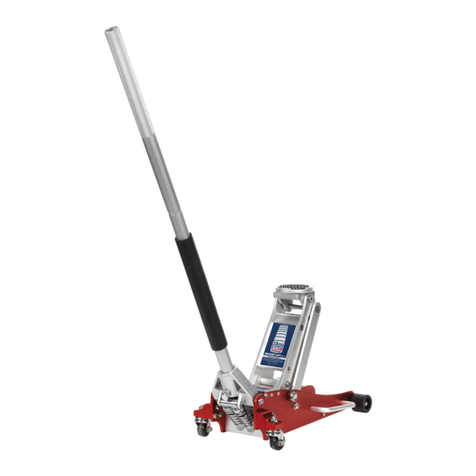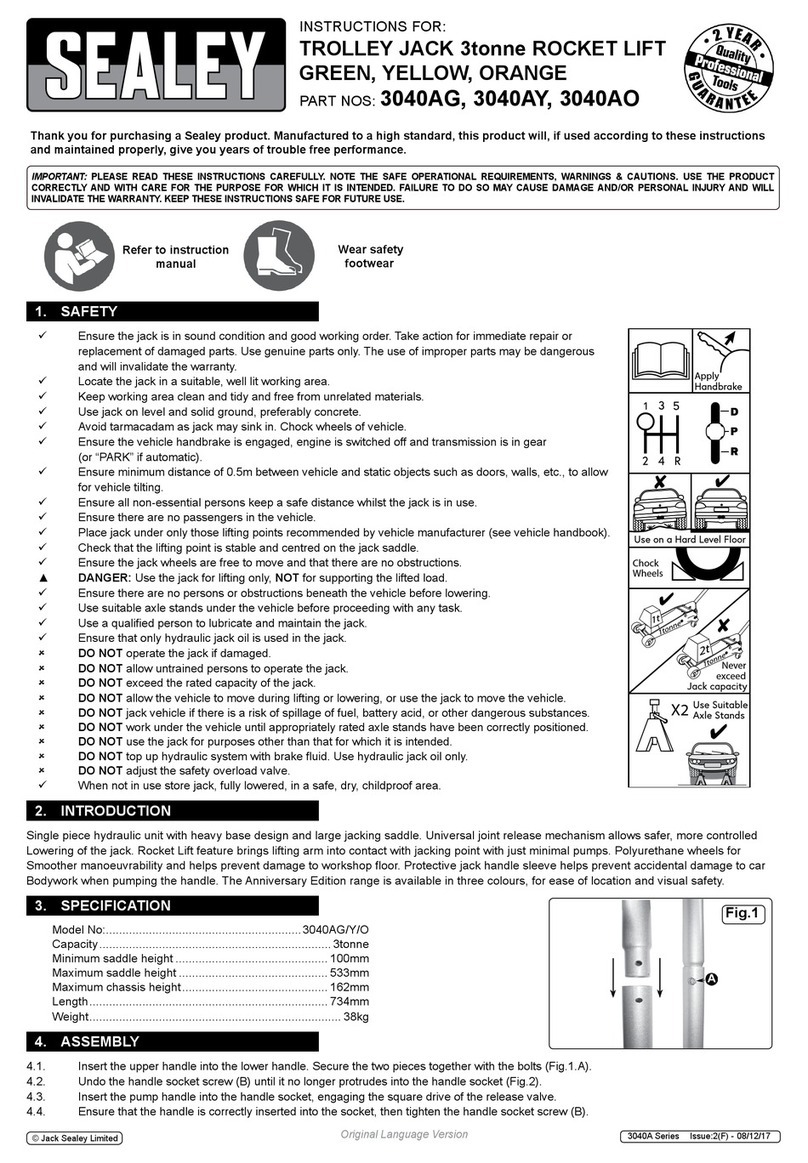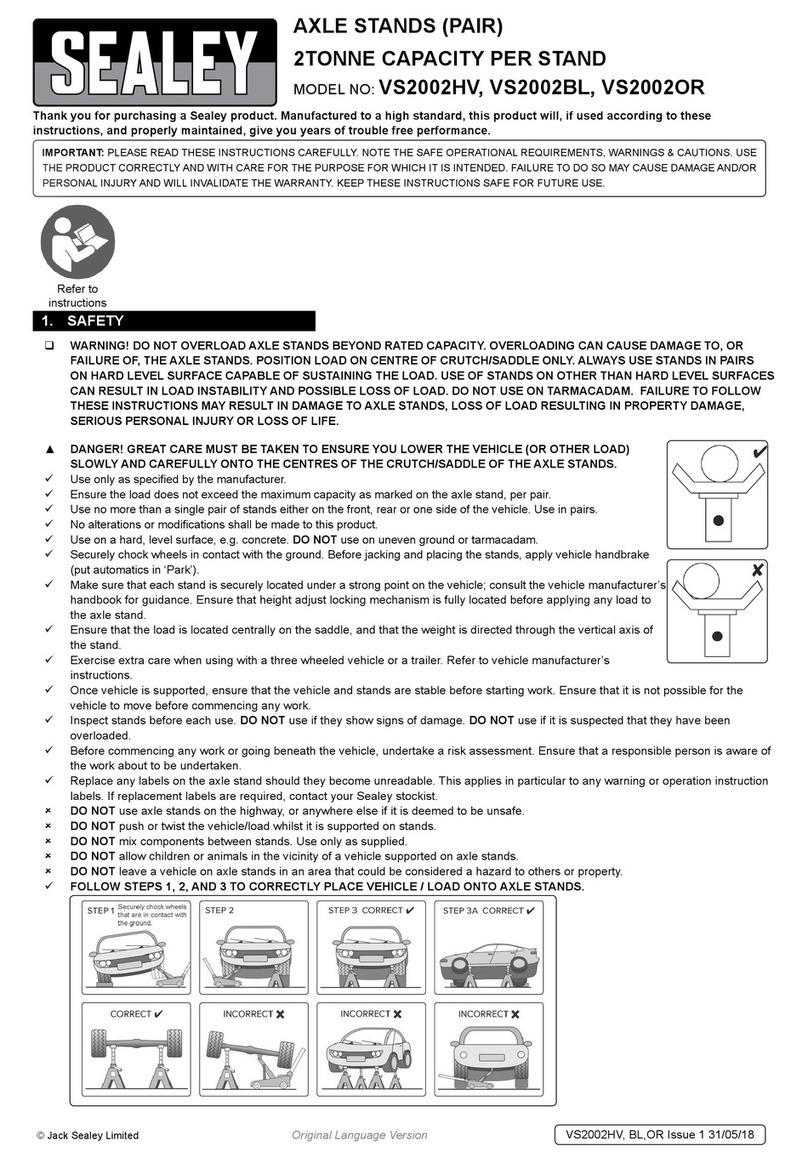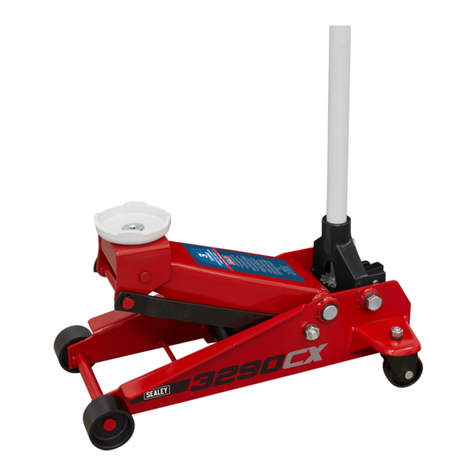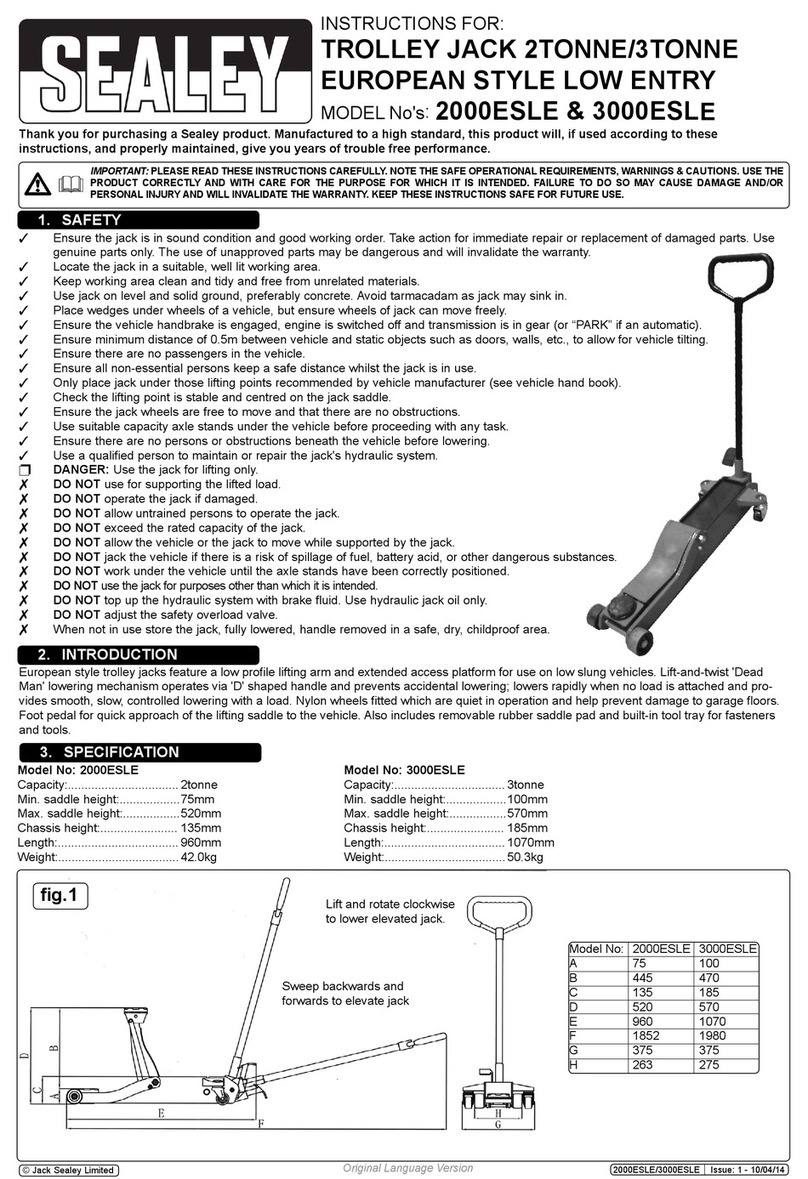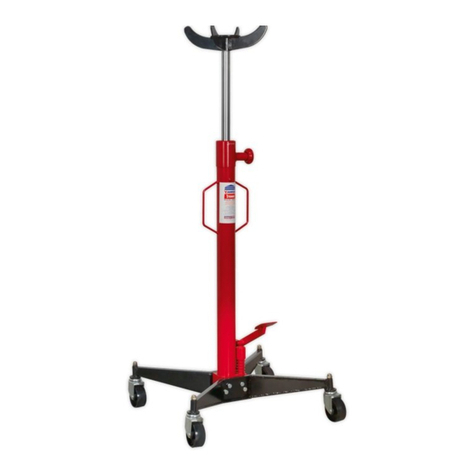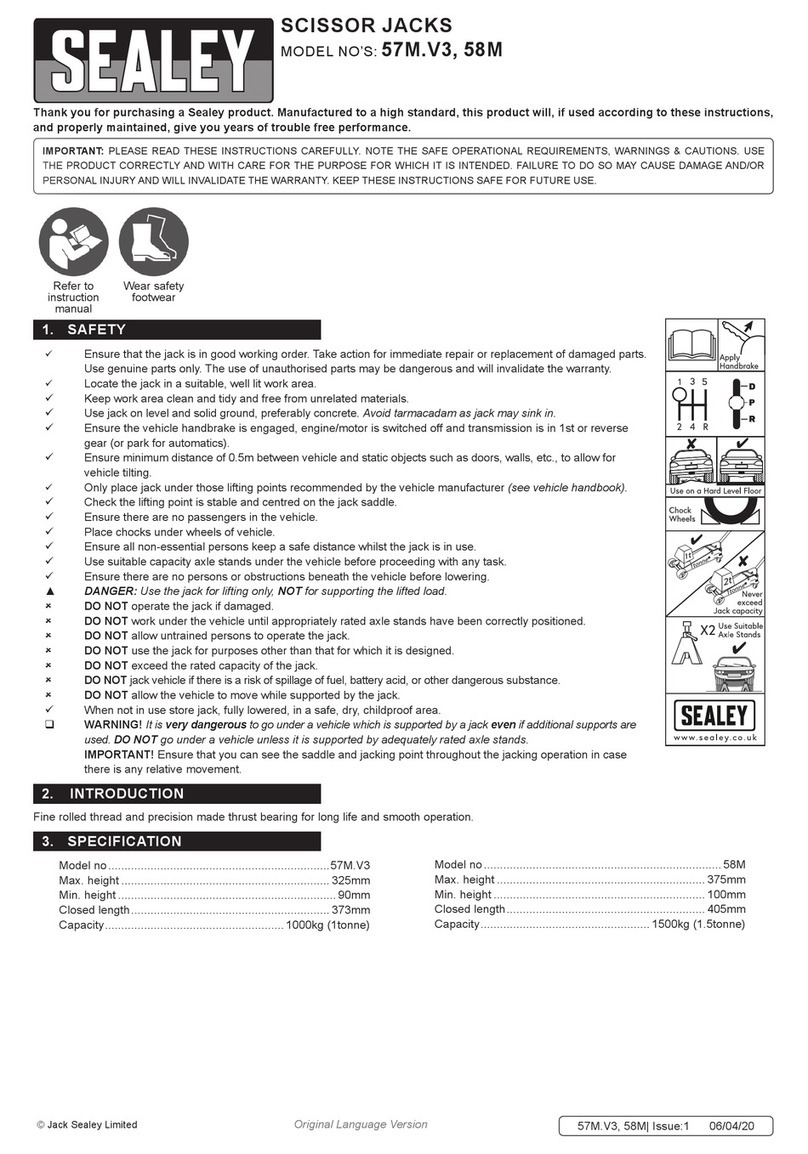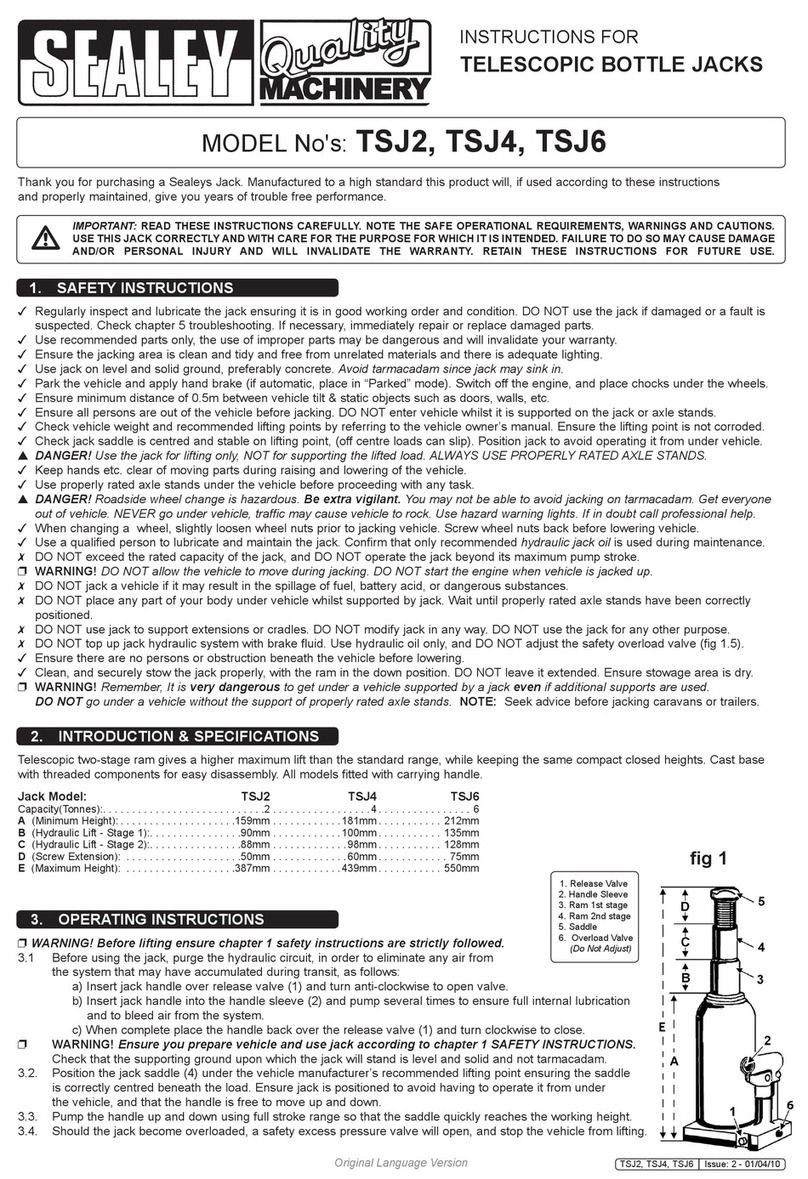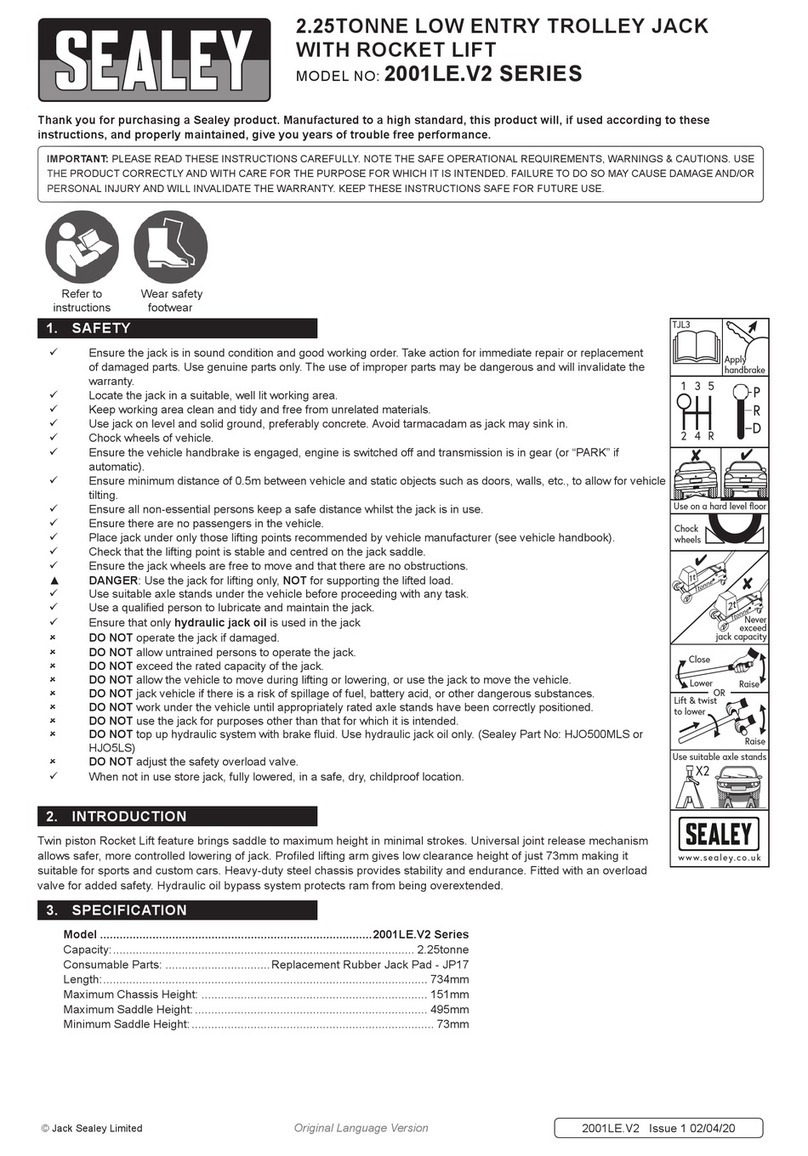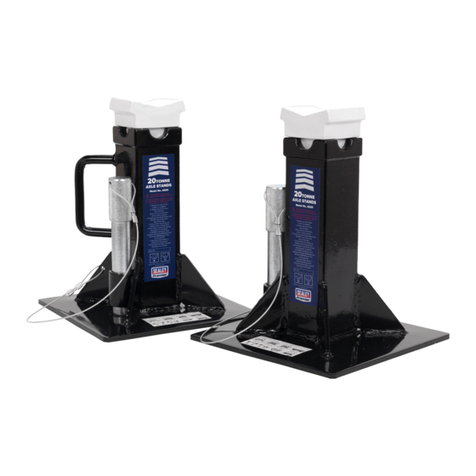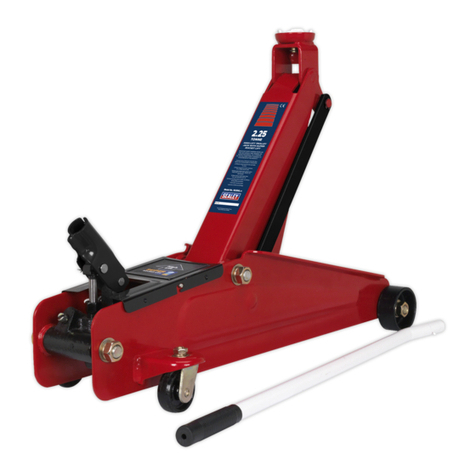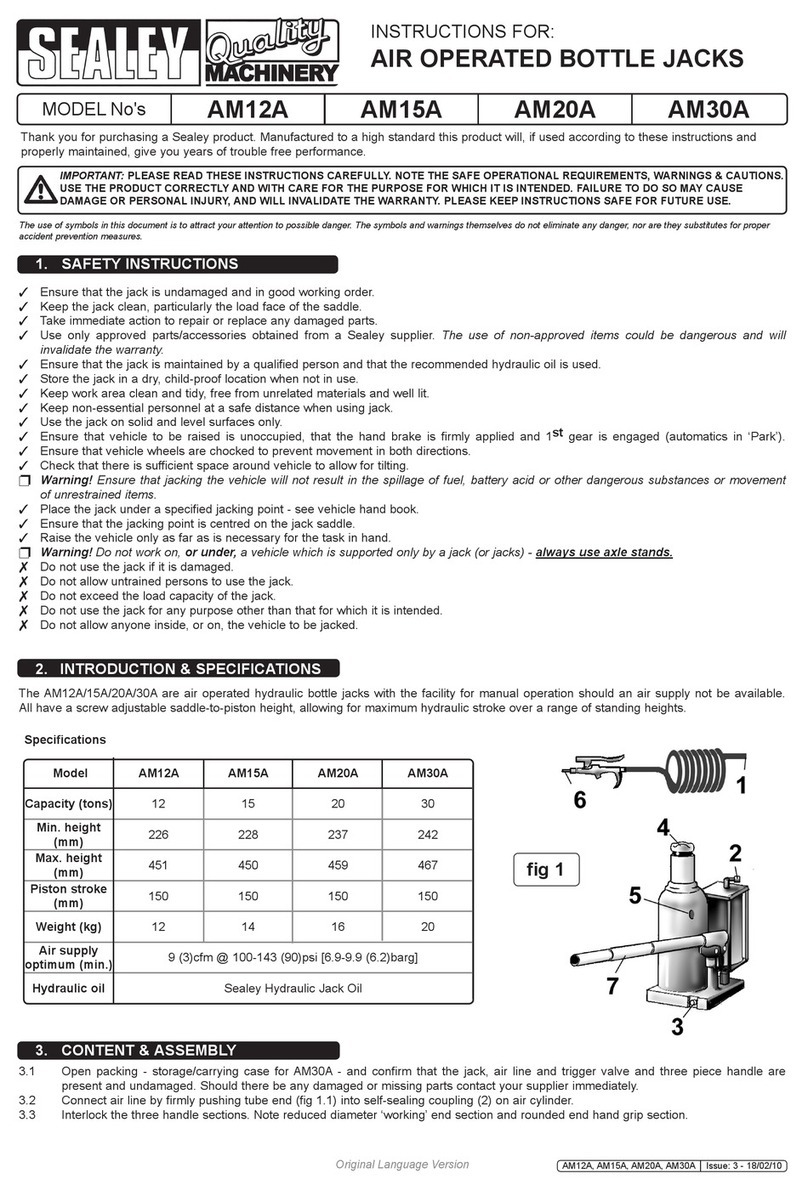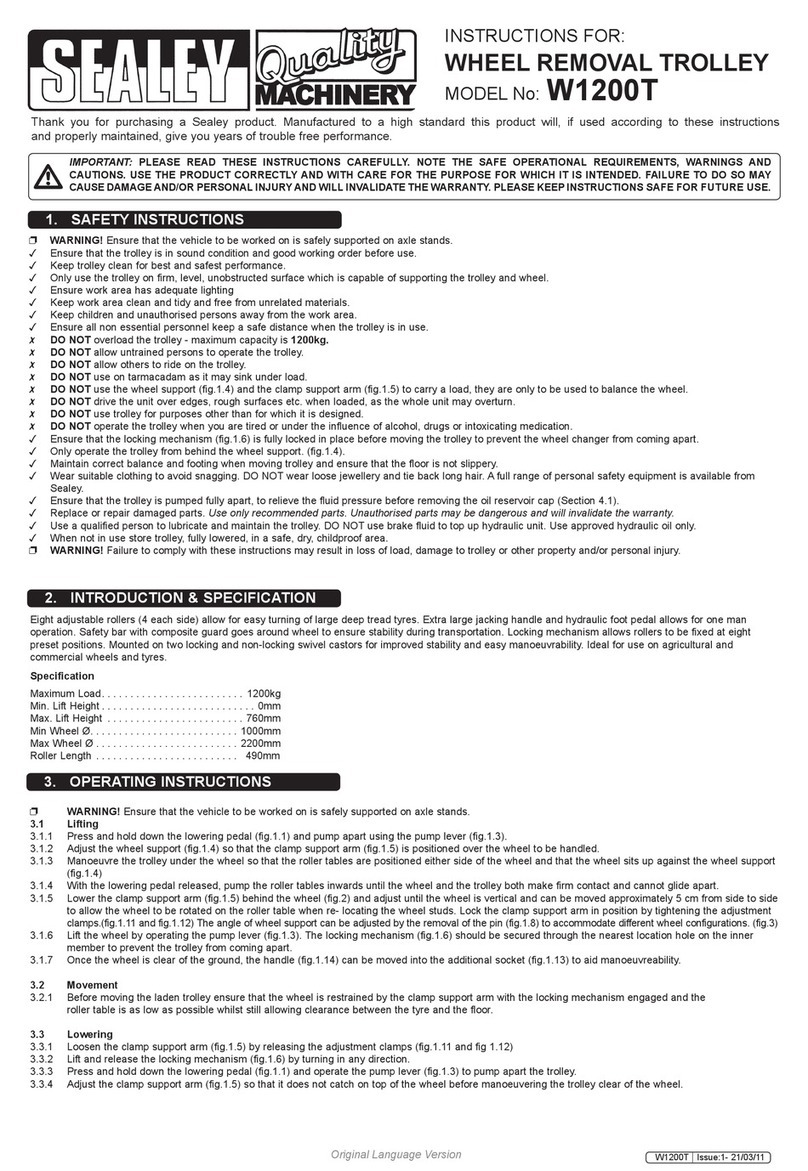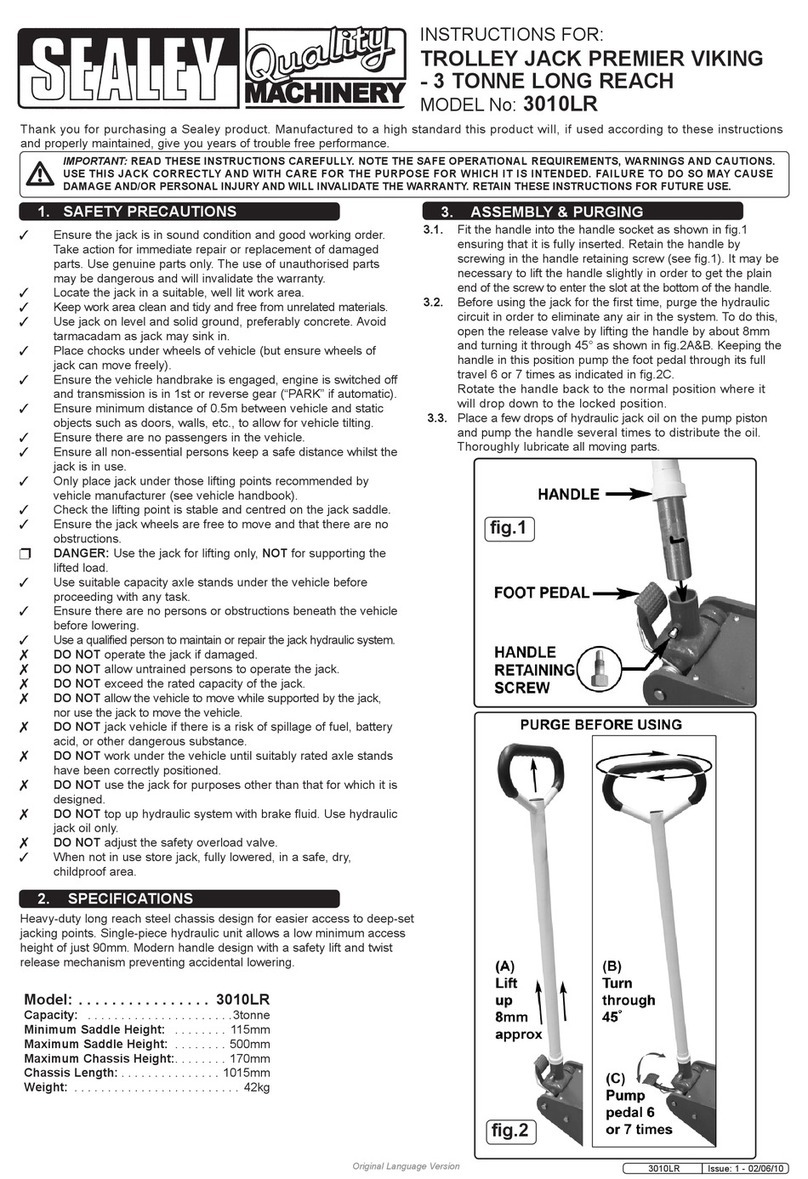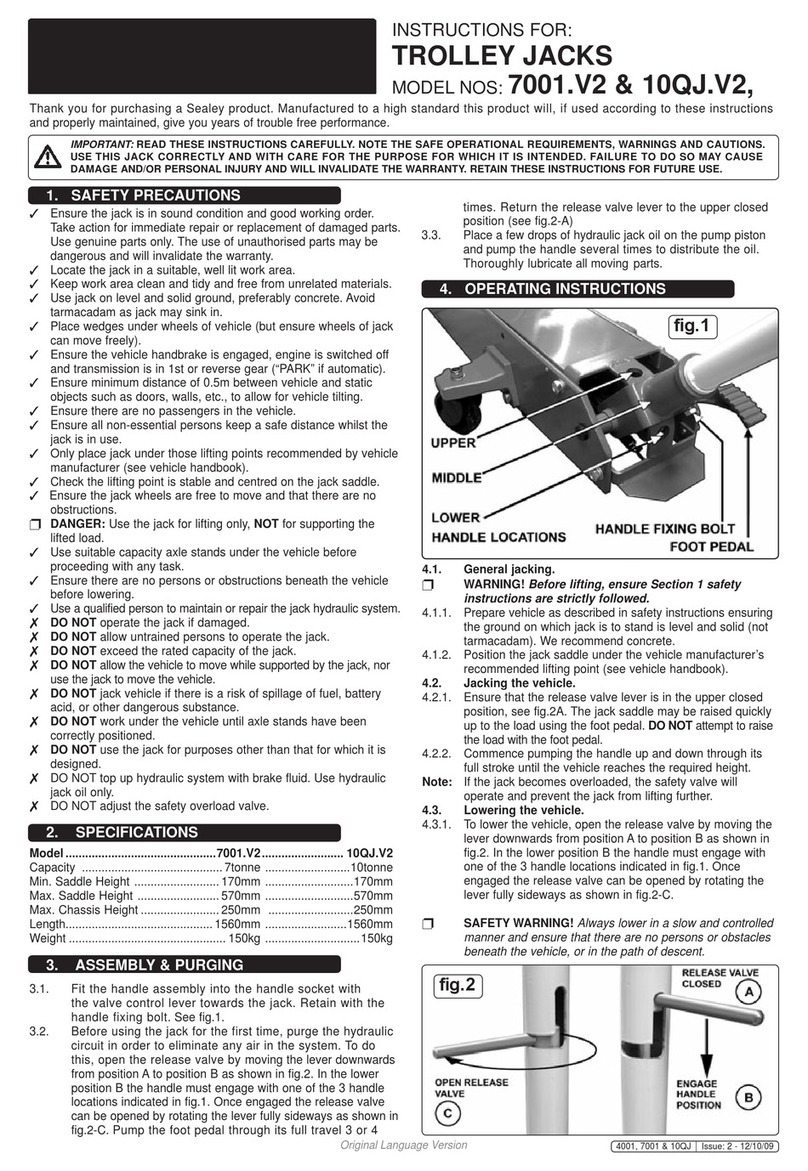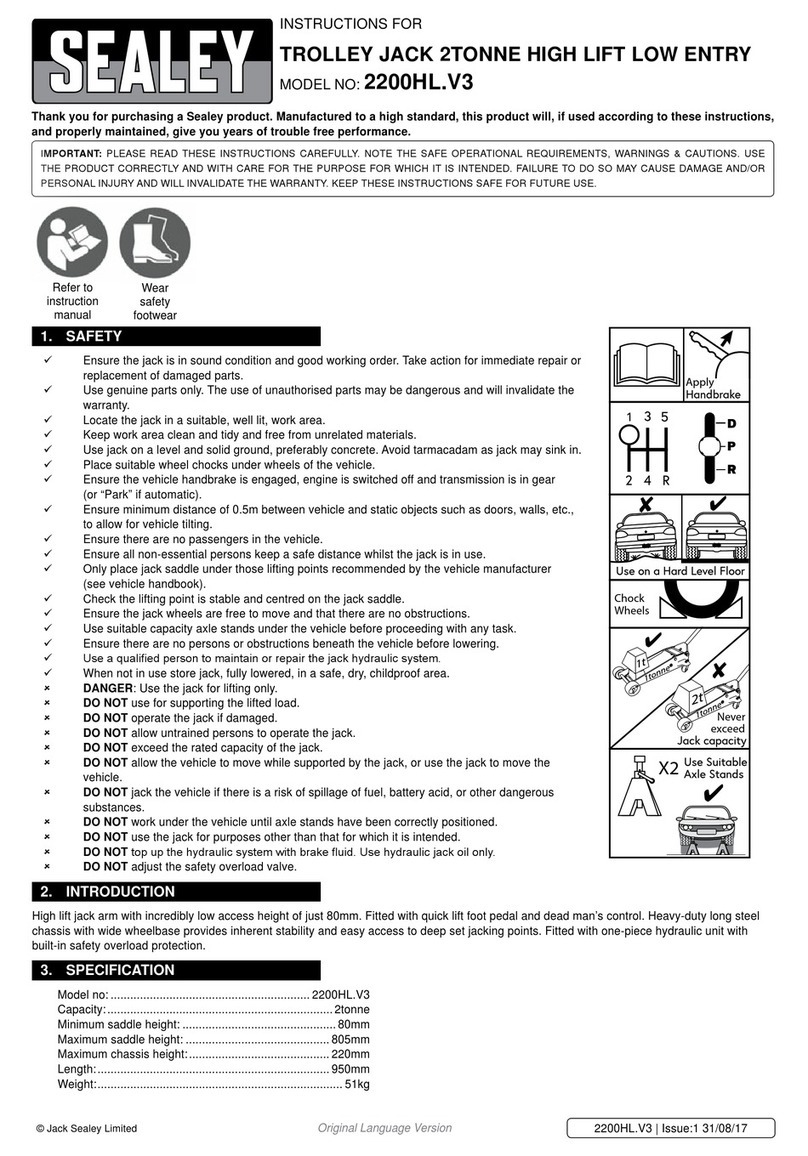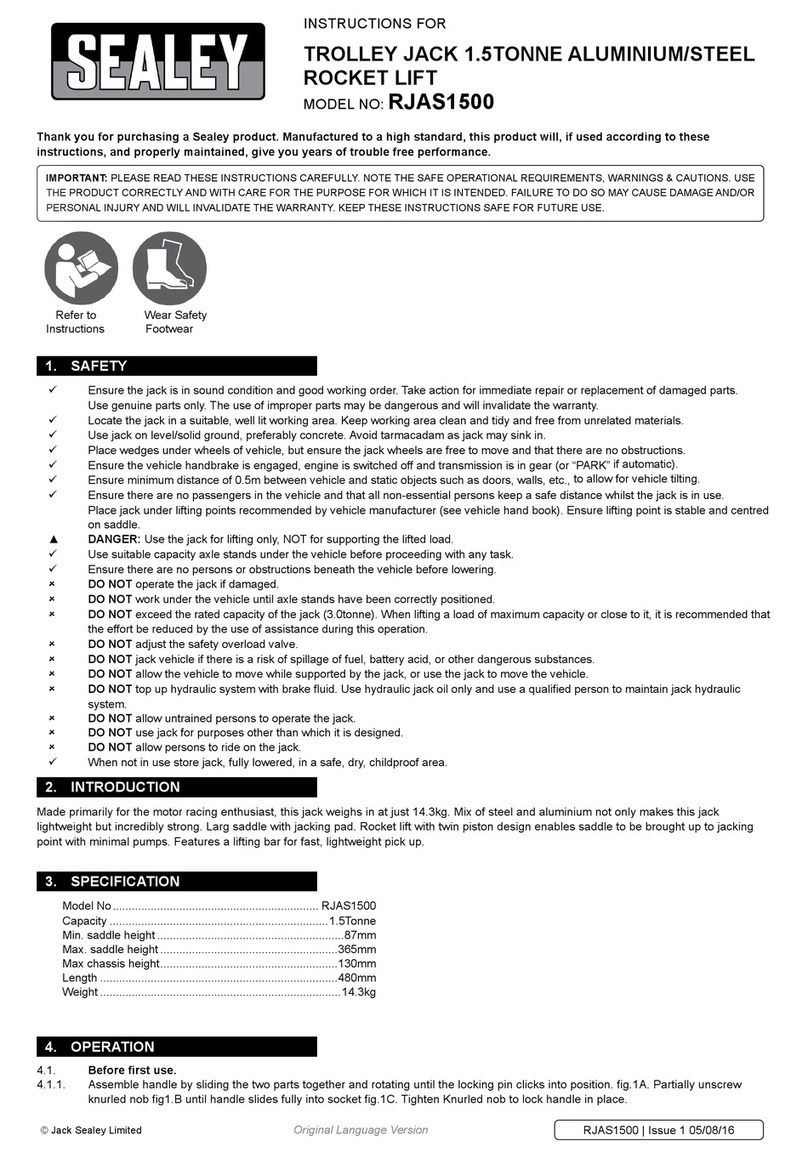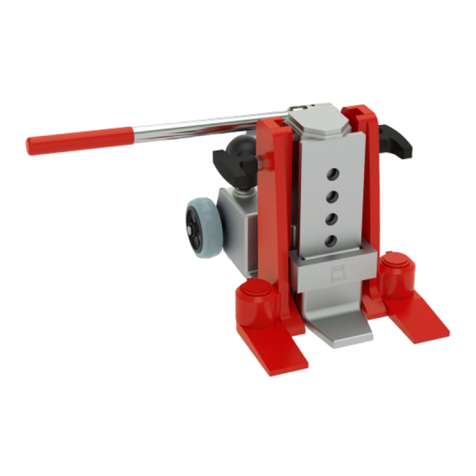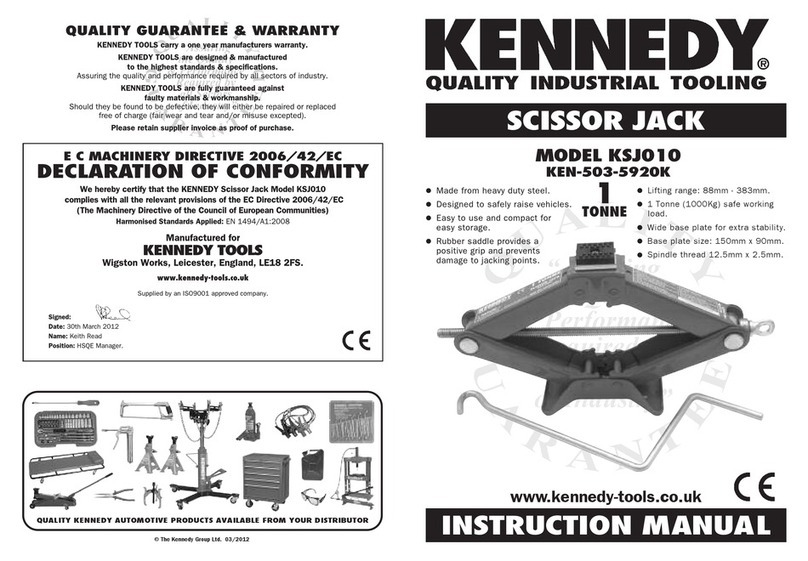TROLLEY JACK
! Ensure the jack is in sound condition and good working order. Take action for immediate repair or replacement of damaged parts.
Use genuine parts only. The use of improper parts may be dangerous and will invalidate the warranty.
!Locate the jack in a suitable, well lit working area.
!Keep working area clean and tidy and free from unrelated materials.
!Use jack on level and solid ground, preferably concrete. Avoid tarmacadam as jack may sink in.
!Place wedges under wheels of vehicle (but ensure wheels of jack can freely move).
!Ensure the vehicle handbrake is engaged, engine is switched off and transmission is in gear (or “PARK” if automatic).
!Ensure minimum distance of 0.5m between vehicle and static objects such as doors, walls, etc., to allow for vehicle tilting.
!Ensure there are no passengers in the vehicle.
!Ensure all non-essential persons keep a safe distance whilst the jack is in use.
!Only place jack under those lifting points recommended by vehicle manufacturer (see vehicle handbook).
!Check the lifting point is stable and centred on the jack saddle.
! Ensure the jack wheels are free to move and that there are no obstructions.
# DANGER: Use the jack for lifting only, NOT for supporting the lifted load.
!Use suitable capacity axle stands under the vehicle before proceeding with any task.
! Ensure there are no persons or obstructions beneath the vehicle before lowering.
!Use a qualified person to maintain or repair the jack hydraulic system.
$ DO NOT operate the jack if damaged.
$ DO NOT allow untrained persons to operate the jack.
$ DO NOT exceed the rated capacity of the jack.
$ DO NOT allow the vehicle to move while supported by the jack, or use the jack to move the vehicle.
$ DO NOT jack vehicle if there is a risk of spillage of fuel, battery acid, or other dangerous substances.
$ DO NOT work under the vehicle until axle stands have been correctly positioned.
$ DO NOT use the jack for purposes other than that for which it is intended.
$ DO NOT top up hydraulic system with brake fluid. Use hydraulic jack oil only.
$ DO NOT adjust the safety overload valve.
! When not in use store jack, fully lowered, in a safe, dry, childproof area.
INSTRUCTIONS FOR:
TROLLEY JACK AND AXLE STANDS
MODEL: 1030CXDK
Your new Jack is produced and manufactured to a high standard of dependability and will, if used according to these instructions and properly
maintained, give you years of trouble free performance.
IMPORTANT: READ THESE INSTRUCTIONS CAREFULLY. NOTE THE SAFE OPERATIONAL REQUIREMENTS, WARNINGS AND CAUTIONS. USE
THIS JACK CORRECTLY AND WITH CARE FOR THE PURPOSE FOR WHICH IT IS INTENDED. FAILURE TO DO SO MAY CAUSE DAMAGE OR
PERSONAL INJURY AND WILL INVALIDATE THE WARRANTY. RETAIN THESE INSTRUCTIONS FOR FUTURE USE.
1. SAFETY PRECAUTIONS
1030CXDK - 1 - 251007
%DANGER!DO NOT OVERLOAD AXLE STANDS BEYOND RATED CAPACITY . OVERLOADING CAN CAUSE DAMAGE TO, OR FAILURE OF, THE
AXLE STANDS. POSITION LOAD ON CENTRE OF SADDLE ONLY. ALWAYS USE STANDS IN PAIRS ON HARD LEVEL SURFACE CAPABLE OF
SUSTAINING THE LOAD. USE OF STANDS ON OTHER THAN HARD LEVEL SURFACES CAN RESULT IN LOAD INSTABILITY AND POSSIBLE LOSS
OF LOAD. DO NOT USE ON TARMACADAM. FAILURE TO FOLLOW THESE INSTRUCTIONS, MAY RESULT IN DAMAGE TO AXLE STANDS, LOSS OF
LOAD, RESULTING IN PROPERTY DAMAGE, SERIOUS PERSONAL INJURY, OR LOSS OF LIFE.
AXLE STANDS
!Ensure axle stands are in good order and condition. DO NOT use if damaged.
!Ensure you familiarise yourself with the product and its folding mechanism. Ensure the locking pin is in place before use.
!Apply handbrake and chock wheels before jacking and using stands. (Put automatics in ‘Park’)
!When raising centre column to engage load ensure centre of saddle is located under vehicle’s jacking point.
Refer to vehicle handbook for jacking points.
%DANGER! Great care must be taken to ensure you lower the vehicle load slowly and carefully onto stands.
!Ensure that vehicle and stands are stable before starting work.
$DO NOT use on soft ground or tarmacadam. Use on concrete only.
$DO NOT use single stand. Only use in pairs.
$DO NOT support more than 4 tons per pair (capacity = 2 ton per stand).
$DO NOT use 4 stands on one vehicle.
$DO NOT jack on end of vehicle if the other end is already on stands.
$DO NOT use for three wheeled vehicles or trailers. Refer to maker’s instructions.
$DO NOT use stands if damaged.
2. SPECIFICATIONS
AXLE STANDS
Capacity Each . . . . . . . . . . . . . . . . . . . . . .2ton
Capacity Pair . . . . . . . . . . . . . . . . . . . . . . .4ton
Minimum Height . . . . . . . . . . . . . . . . . . . .275mm
Maximum Height . . . . . . . . . . . . . . . . . . . .365mm
TROLLEY JACK
Capacity . . . . . . . . . . . . . . . . . . . . . . . . . . . . . . . .2ton
Minimum Saddle Height . . . . . . . . . . . . . . . . . .130mm
Maximum Saddle Height . . . . . . . . . . . . . . . . .330mm
Maximum Chassis Height . . . . . . . . . . . . . . . . .140mm
Length . . . . . . . . . . . . . . . . . . . . . . . . . . . . . . .440mm
Weight . . . . . . . . . . . . . . . . . . . . . . . . . . . . . . . . . 8kg

